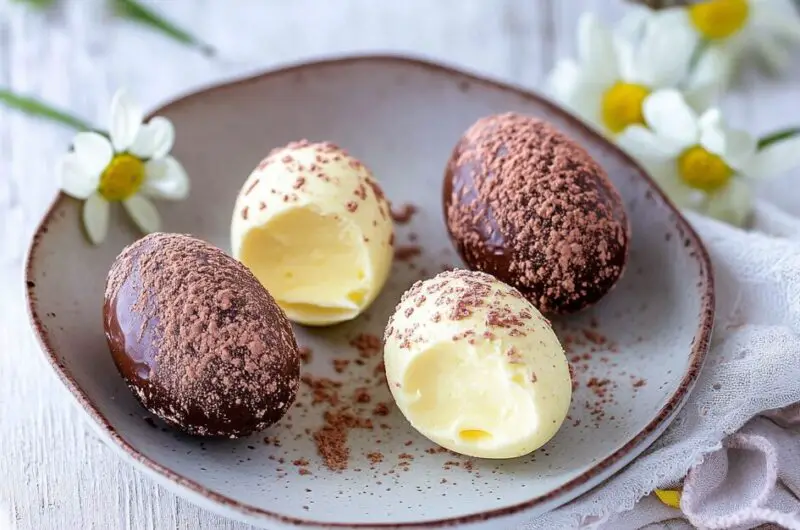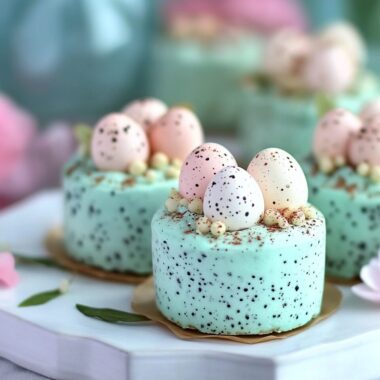Easter is the perfect time to indulge in sweet, festive treats, and these homemade Easter Cream Eggs are a must-try! With a luscious, creamy center wrapped in a smooth, rich chocolate shell, they are the ultimate homemade alternative to store-bought candy. The fun part? Creating the “yolk” filling to mimic real eggs, making these treats not only delicious but visually stunning as well. Whether you’re making them for kids’ Easter baskets, as a holiday dessert, or simply for a fun baking project, these homemade cream eggs will surely impress. They’re easy to prepare, require just a handful of ingredients, and can be customized with different chocolate coatings or flavors. These delightful treats will add a touch of homemade magic to your Easter celebration!
Full recipe:
Ingredients:
- 1/2 cup unsalted butter, softened
- 1/4 teaspoon salt
- 1 teaspoon vanilla extract
- 4 cups powdered sugar
- 1/4 cup heavy cream
- Yellow food coloring (for the “yolk”)
- 2 cups semi-sweet chocolate chips
- 1 tablespoon coconut oil or vegetable shortening
Directions:
- In a mixing bowl, cream together butter, salt, and vanilla extract until smooth.
- Gradually add powdered sugar and heavy cream, mixing until a thick, dough-like consistency forms.
- Separate about 1/4 of the filling and dye it yellow with food coloring.
- Roll small portions of the yellow filling into tiny balls to resemble yolks.
- Wrap a larger portion of the white filling around each yellow ball, shaping them into egg forms.
- Place the shaped eggs on a parchment-lined baking sheet and freeze for about 30 minutes.
- Melt chocolate chips and coconut oil in a microwave-safe bowl in 30-second intervals, stirring until smooth.
- Dip each chilled cream egg into the melted chocolate, coating evenly.
- Place the coated eggs back onto the baking sheet and refrigerate until set.
Prep Time: 20 minutes | Chill Time: 30 minutes | Total Time: 50 minutes
Kcal: 220 kcal | Servings: 12 eggs
The Ultimate Guide to Homemade Easter Cream Eggs
Easter is one of the most joyous holidays of the year, filled with traditions, family gatherings, and of course, delicious treats. Among the many sweets enjoyed during this season, chocolate eggs hold a special place. While store-bought versions dominate supermarket shelves, nothing compares to the rich, creamy, and customizable goodness of Easter Cream Eggs. This guide explores the history behind these delightful treats, the benefits of making them at home, different variations to try, and expert tips to ensure you create the most decadent Easter eggs possible.
The History of Chocolate Easter Eggs
Chocolate eggs have been an Easter tradition for centuries, but their origins date back even further. Eggs have long been a symbol of rebirth and renewal, aligning perfectly with the themes of spring and Easter celebrations. The practice of giving decorated eggs goes back to ancient civilizations, including the Persians, Egyptians, and Romans. In the 19th century, chocolatiers in Europe began crafting chocolate eggs to celebrate Easter. Early versions were solid chocolate, but as chocolate-making techniques advanced, filled eggs with soft centers emerged. Cadbury, one of the most famous chocolatiers, introduced its first cream-filled Easter eggs in the 1920s, and they quickly became a global sensation. Today, the tradition of indulging in chocolate eggs continues, but many people are turning to homemade versions for a fresher, more customizable experience.
Why Homemade Easter Cream Eggs Are the Best
While store-bought Easter eggs are convenient, making them from scratch has several advantages:
Superior Taste and Quality
- Homemade Easter cream eggs are crafted with high-quality ingredients, free from artificial additives or preservatives. The result is a rich, creamy filling with a fresh, buttery taste that surpasses any mass-produced version.
Customizable to Suit Your Preferences
- When making your own cream eggs, you have complete control over the flavors, fillings, and chocolate coating. You can adjust the sweetness, add unique ingredients like caramel or peanut butter, or even experiment with different types of chocolate, from milk to dark or white chocolate.
Healthier Options Available
- Unlike commercial chocolate eggs, which often contain high-fructose corn syrup and artificial colors, homemade versions allow you to use wholesome, natural ingredients. You can opt for organic dairy, reduce the sugar content, or even make dairy-free and keto-friendly alternatives.
Fun and Engaging Activity
- Making Easter cream eggs is a fantastic way to bring family and friends together. Kids love shaping the eggs, dipping them in chocolate, and decorating them with sprinkles or edible glitter. It’s a perfect way to create lasting Easter memories.
Perfect for Gifting and Celebrations
- Handmade chocolate eggs make thoughtful gifts, whether wrapped in decorative packaging for Easter baskets or displayed as part of an Easter dessert table. They add a personal touch that store-bought candies simply can’t match.
Step-by-Step Guide to Making Homemade Easter Cream Eggs
Here’s a breakdown of how to make these creamy, chocolate-covered delights from scratch.
Ingredients You’ll Need
- Unsalted Butter – Adds a rich, smooth texture to the filling.
- Powdered Sugar – Creates the signature creamy, sweet center.
- Heavy Cream – Provides a luscious, melt-in-your-mouth consistency.
- Vanilla Extract – Enhances the flavor of the filling.
- Salt – Balances the sweetness for a more refined taste.
- Yellow Food Coloring – Used to create the “yolk” for a fun, realistic look.
- Semi-Sweet Chocolate – A perfect balance between milk and dark chocolate for coating.
- Coconut Oil or Vegetable Shortening – Helps create a smooth, glossy chocolate shell.
How to Make Easter Cream Eggs
Prepare the Filling
- Beat butter, vanilla extract, and salt until creamy.
- Gradually add powdered sugar and heavy cream, mixing until a dough-like consistency forms.
Create the Yolk Effect
- Separate a small portion of the filling and tint it yellow to resemble an egg yolk.
- Roll tiny balls from the yellow filling.
Shape the Eggs
- Wrap white filling around each yellow “yolk” and shape them into eggs.
- Place them on a lined baking sheet and freeze for about 30 minutes.
Melt the Chocolate
- Heat chocolate and coconut oil in a microwave-safe bowl, stirring until smooth.
Coat the Eggs
- Dip each frozen cream egg into the melted chocolate using a fork for even coverage.
- Let excess chocolate drip off before placing the eggs back on the baking sheet.
Set and Enjoy
- Refrigerate the coated eggs until the chocolate hardens.
- Store in an airtight container until ready to serve.
Delicious Variations to Try
Homemade Easter cream eggs can be customized in countless ways. Here are a few fun variations to experiment with:
Dark Chocolate Raspberry Cream Eggs
- Add freeze-dried raspberry powder to the filling for a fruity twist.
- Coat in dark chocolate for a rich, tangy balance.
Peanut Butter Cream Eggs
- Replace part of the butter with peanut butter for a nutty, decadent filling.
- Drizzle with white chocolate for a decorative touch.
Coconut Cream Eggs
- Mix shredded coconut into the filling for added texture.
- Use milk chocolate for a smooth, tropical flavor.
Coffee-Infused Cream Eggs
- Add a teaspoon of espresso powder to the filling for a mocha-inspired treat.
- Best paired with dark chocolate for a bold taste.
Vegan Easter Cream Eggs
- Substitute butter with coconut oil and use almond milk instead of heavy cream.
- Use dairy-free chocolate for the coating.
Expert Tips for Perfect Cream Eggs
Use High-Quality Chocolate
- Opt for couverture chocolate for the smoothest, most luxurious shell.
Keep the Filling Cool
- Chilling the filling before shaping prevents it from becoming too sticky.
Don’t Overheat the Chocolate
- Melt chocolate in short intervals to prevent burning.
Work in Small Batches
- Dip only a few eggs at a time to ensure the chocolate doesn’t harden before coating.
Add a Decorative Touch
- Drizzle with white or dark chocolate, add sprinkles, or dust with edible gold for a festive presentation.
How to Store Homemade Easter Cream Eggs
- Refrigerator: Store in an airtight container for up to two weeks.
- Freezer: Can be frozen for up to two months; allow to thaw slightly before eating.
- Room Temperature: If consuming within a day, keep in a cool, dry place to prevent melting.
Conclusion
Easter cream eggs are more than just a delicious treat—they’re a way to celebrate tradition, bring families together, and enjoy the satisfaction of making something from scratch. Whether you stick to the classic vanilla cream version or experiment with different flavors, these delightful eggs are sure to become a yearly Easter favorite. With a little effort and creativity, you can create a batch of irresistible, handmade chocolate eggs that rival any store-bought candy. So why not make this Easter extra special by crafting your own homemade cream eggs? Your taste buds—and your loved ones—will thank you!







